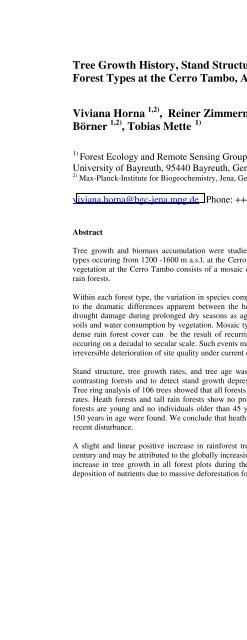A Look at Amazon Basin Seasonal Dynamics with the Biophysical ...
A Look at Amazon Basin Seasonal Dynamics with the Biophysical ... A Look at Amazon Basin Seasonal Dynamics with the Biophysical ...
Tree Growth History, Stand Structure, and Biomass of PremontaneForest Types at the Cerro Tambo, Alto Mayo, Northern PeruViviana Horna 1,2) , Reiner Zimmermann 1,2) , Henry Soplin 1) , AnnettBörner 1,2) , Tobias Mette 1)1)Forest Ecology and Remote Sensing Group, Ecological-Botanical Gardens ÖBG,University of Bayreuth, 95440 Bayreuth, Germany2) Max-Planck-Institute for Biogeochemistry, Jena, Germany.viviana.horna@bgc-jena.mpg.de Phone: ++49-3641-686731 Fax: ++49-3641-686710AbstractTree growth and biomass accumulation were studied for two structurally contrasting premontane foresttypes occuring from 1200 -1600 m a.s.l. at the Cerro Tambo, Region Alto Mayo in Peru. The premontanevegetation at the Cerro Tambo consists of a mosaic of poor heath forests and well developed premontanerain forests.Within each forest type, the variation in species composition and aboveground biomass is small comparedto the dramatic differences apparent between the heath and rain forests. Edaphic variations and severedrought damage during prolonged dry seasons as agent for such differences was excluded by studies onsoils and water consumption by vegetation. Mosaic type heath forest establishment in a zone with potentialdense rain forest cover can be the result of recurring destructive events like natural fires or landslides,occuring on a decadal to secular scale. Such events may trigger a series of successional stages which lead toirreversible deterioration of site quality under current conditions.Stand structure, tree growth rates, and tree age was measured to describe the growth dynamics of thecontrasting forests and to detect stand growth depressions within the life span of old growth individuals.Tree ring analysis of 106 trees showed that all forests of the Cerro Tambo area have low annual tree growthrates. Heath forests and tall rain forests show no pronounced difference in growth rates. However, heathforests are young and no individuals older than 45 years were found. Tall rain forests trees of more than150 years in age were found. We conclude that heath forests are most likely successional stages after fairlyrecent disturbance.A slight and linear positive increase in rainforest tree growth in all forest plots was found for the pastcentury and may be attributed to the globally increasing atmospheric CO 2 concentration. A further observedincrease in tree growth in all forest plots during the last two decades may be attributed to atmosphericdeposition of nutrients due to massive deforestation followed by rural development in this region.
- Page 272: Response of photosynthesis to diffe
- Page 276: 1 Trumbore et al., 1996
- Page 280: Effect of Soil Texture on Carbon Dy
- Page 284: Relationship Between Litter Product
- Page 288: Regrowth Biomass Estimation in the
- Page 292: Effects of Interannual Climate Vari
- Page 296: Carbon balance and vegetation dynam
- Page 300: SOIL CARBON STOCKS INFLUENCED BY LI
- Page 304: Drought effects on net primary prod
- Page 308: COARSE WOOD DEBRIS DEPOSITION, DECO
- Page 312: Soil properties and carbon sequestr
- Page 316: Patiño, S. 1,2,a , Mercado, L. 2 ,
- Page 320: Where are the oldest of the forest?
- Page 326: Ecosystem degradation due to fire &
- Page 330: AbstractMulti-temporal Analysis of
- Page 334: ABSTRACT - Second International LBA
- Page 338: Mapping Biomass Loss from Forest Fi
- Page 342: Spatial and Temporal Drivers of Fir
- Page 346: A new method to detect forest fire
- Page 350: Forest Canopy Damage from Selective
- Page 354: AcknowledgementsSupport of this res
- Page 358: Carbon Storage in Soils from Degrad
- Page 362: An improved soil water budget model
- Page 366: PATTERNS OF TREE MORTALITY IN FORES
- Page 370: RAIN WATER INTERCEPTION BY SELECTIV
Tree Growth History, Stand Structure, and Biomass of PremontaneForest Types <strong>at</strong> <strong>the</strong> Cerro Tambo, Alto Mayo, Nor<strong>the</strong>rn PeruViviana Horna 1,2) , Reiner Zimmermann 1,2) , Henry Soplin 1) , AnnettBörner 1,2) , Tobias Mette 1)1)Forest Ecology and Remote Sensing Group, Ecological-Botanical Gardens ÖBG,University of Bayreuth, 95440 Bayreuth, Germany2) Max-Planck-Institute for Biogeochemistry, Jena, Germany.viviana.horna@bgc-jena.mpg.de Phone: ++49-3641-686731 Fax: ++49-3641-686710AbstractTree growth and biomass accumul<strong>at</strong>ion were studied for two structurally contrasting premontane foresttypes occuring from 1200 -1600 m a.s.l. <strong>at</strong> <strong>the</strong> Cerro Tambo, Region Alto Mayo in Peru. The premontaneveget<strong>at</strong>ion <strong>at</strong> <strong>the</strong> Cerro Tambo consists of a mosaic of poor he<strong>at</strong>h forests and well developed premontanerain forests.Within each forest type, <strong>the</strong> vari<strong>at</strong>ion in species composition and aboveground biomass is small comparedto <strong>the</strong> dram<strong>at</strong>ic differences apparent between <strong>the</strong> he<strong>at</strong>h and rain forests. Edaphic vari<strong>at</strong>ions and severedrought damage during prolonged dry seasons as agent for such differences was excluded by studies onsoils and w<strong>at</strong>er consumption by veget<strong>at</strong>ion. Mosaic type he<strong>at</strong>h forest establishment in a zone <strong>with</strong> potentialdense rain forest cover can be <strong>the</strong> result of recurring destructive events like n<strong>at</strong>ural fires or landslides,occuring on a decadal to secular scale. Such events may trigger a series of successional stages which lead toirreversible deterior<strong>at</strong>ion of site quality under current conditions.Stand structure, tree growth r<strong>at</strong>es, and tree age was measured to describe <strong>the</strong> growth dynamics of <strong>the</strong>contrasting forests and to detect stand growth depressions <strong>with</strong>in <strong>the</strong> life span of old growth individuals.Tree ring analysis of 106 trees showed th<strong>at</strong> all forests of <strong>the</strong> Cerro Tambo area have low annual tree growthr<strong>at</strong>es. He<strong>at</strong>h forests and tall rain forests show no pronounced difference in growth r<strong>at</strong>es. However, he<strong>at</strong>hforests are young and no individuals older than 45 years were found. Tall rain forests trees of more than150 years in age were found. We conclude th<strong>at</strong> he<strong>at</strong>h forests are most likely successional stages after fairlyrecent disturbance.A slight and linear positive increase in rainforest tree growth in all forest plots was found for <strong>the</strong> pastcentury and may be <strong>at</strong>tributed to <strong>the</strong> globally increasing <strong>at</strong>mospheric CO 2 concentr<strong>at</strong>ion. A fur<strong>the</strong>r observedincrease in tree growth in all forest plots during <strong>the</strong> last two decades may be <strong>at</strong>tributed to <strong>at</strong>mosphericdeposition of nutrients due to massive deforest<strong>at</strong>ion followed by rural development in this region.



